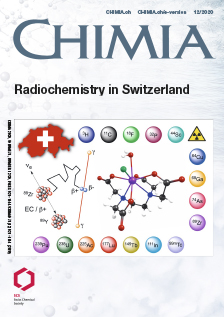Determination of Plutonium and Uranium Radionuclides in Glacier Ice Samples by MC-ICP-MS
DOI:
https://doi.org/10.2533/chimia.2020.989PMID:
33357293Keywords:
Gauli glacier, Mc-icp-ms, 239pu, 240pu/239pu, 236uAbstract
A radiochemical procedure for the determination of plutonium (Pu) and uranium (U) radionuclides in ice samples by multicollector inductively coupled plasma mass spectrometer (MC-ICP-MS) is presented. Pu and U radionuclides are preconcentrated by coprecipitation and then separated by extraction chromatography. The purified Pu and U fractions are analyzed by MC-ICP-MS. Detection limits of 2 × 10 –3 and 3 × 10–6 mBq kg–1 were achieved for 239Pu and 236U, respectively. Surface ice samples collected from the Gauli glacier (Switzerland) were analyzed by this method. The surface of the Gauli Glacier retains historical records of 239Pu, 240Pu and 236U from the nuclear weapon testing (NWT) period. Pu and U radionuclides were found to be consistent in terms of pattern, showing two peaks possibly related to the two main periods of the NWTs (1954–1958 and 1961–1963). 3H measurements, also released by the NWT, further confirmed the Pu and U results. The 240Pu/239Pu ratio ranged from 0.14 to 0.25, and 236U/ 239Pu ranged from 0.14 to 0.81. The Pu atom ratios ranged within the limits of global fallout in the most intensive period of NWT (1952 to 1962).Downloads
Published
2020-12-23
Issue
Section
Scientific Articles
License
Copyright (c) 2020 Stefan Röllin, Hans Sahli, Lars Gnägi, José A. Corcho Alvarado

This work is licensed under a Creative Commons Attribution-NonCommercial 4.0 International License.
How to Cite
[1]
S. Röllin, H. Sahli, L. Gnägi, J. A. Corcho Alvarado, Chimia 2020, 74, 989, DOI: 10.2533/chimia.2020.989.







